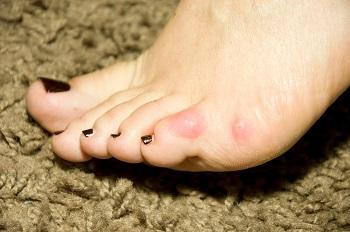What Are Corns?
- posted: Feb. 19, 2019
Many people think corns and calluses are the same thing, but there are differences. A corn is smaller than a callus, and has a hard center which is surrounded by inflamed tissue. Unlike calluses, corns can be painful and make it difficult to wear shoes. The good news is, your podiatrist can help get rid of corns and get you back on your feet.
on your feet.
Corns typically develop to protect your feet and toes from friction and pressure. They can be found in both weight bearing and non-weight bearing areas including between your toes, and on the tops and sides of your toes.
According to the Mayo Clinic, common signs and symptoms of a corn include:
- A thick, rough area of skin
- A hardened, raised bump
- Tenderness or pain under the skin
Since corns are caused by friction and pressure, you can do a lot to prevent corn development. Remember to:
- Wear shoes with plenty of room for your toes
- Use padding or bandages in your shoes
- Soak your feet in warm water to soften corns
- After soaking, rub the corn with a pumice stone to remove hardened skin
- Moisturize your feet every day to keep your skin soft
If you have diabetes and you develop a corn or other foot problem, you need the help of an expert, your podiatrist. Self-treating foot issues when you are diabetic can lead to injuries that don’t heal and could get worse, resulting in a serious infection.
Fortunately, your podiatrist can recommend several treatment options to get rid of corns, including:
- Trimming away excess skin to reduce friction
- Corn-removing medication containing salicylic acid
- Custom-fit inserts or orthotics
- Surgery if the corn is caused from friction due to poor bone alignment
You don’t have to deal with painful corns by yourself. Get some relief from the pain by visiting your podiatrist. Your feet are important, so seek out the best care possible to protect your feet.
